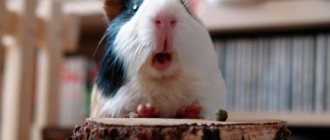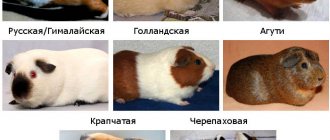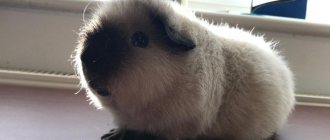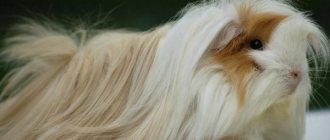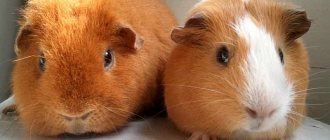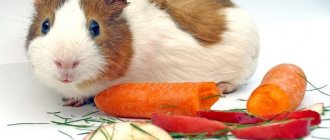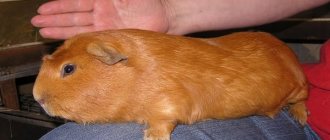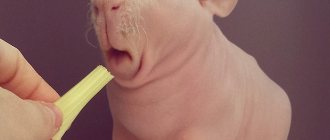Teddy the guinea pig has fluffy fur that makes him look like the famous teddy bear. Thanks to this, the animal received the appropriate name. Teddies are popular as pets due to their peaceful and friendly nature. Information about the characteristics of the breed will help you prepare for possible difficulties in care and maintenance.
Varieties
There are several varieties of Teddy guinea pigs. They differ from each other in the length and structure of their coat. Each type is good in its own way:
- American Teddy. These are the owners of short fur of medium hardness. The ears are almost hairless with drooping tips. The hair on the muzzle is much shorter than on the body.
- Swiss Teddy. This subspecies is distinguished by longer hair, which grows up to 6 cm. The hairs are so hard that they even break under mechanical stress.
- Long-haired Teddy, or Moscow Texel. This variety was created by Russian breeders. Its main difference from others is its smooth, wavy fur, about 15 cm long. The fur on the head and muzzle is shorter than on other parts of the body. An interesting feature of the long-haired Teddy is the presence of luxurious bangs.
Differences between Swiss Teddies
Many owners of Swiss Teddy pigs talk about associations with a ball of fluff. This breed is really distinguished by its special long hair, it can reach up to 8 cm. It sometimes stands on end, which looks very funny. On the head area, the hair length is shorter, and in the belly area, slightly curly islands are visible.
There is no consensus among zoologists as to what type the pig should be classified as: some consider it long-haired, others classify it as short-haired.
There are also differences in body structure: a muscular main body and broad shoulders; at the withers the pets reach a respectable size.
You can also distinguish them by the size of their head: it is short and large. Due to the structural features of the head, baby animals cause many problems, both for breeders and for the mother. Complications can begin if the mother pig gives birth for the first time. With age, the feature becomes less noticeable, and the body proportions become more natural.
The nose is even more pointed than other popular breeds. They are distinguished by large and expressive eyes that are set wide apart. Beautiful looking ears that usually hang down like a rabbit's. A number of individuals have characteristic tufts on their ears, which give them an even cuter appearance.
During the development process, Swiss breed types go through several stages of formation of the body coat. After several months of life, molting may begin and the fur may “lay down.” Shedding is observed in two cases: either during a period of danger to health, or during the young period. Molting in a young pig may begin after 1.5 months of age, but then there will be no problems with the animal. The peculiarity is that if there was no shedding in childhood, then despite the general health of the animals, they will be distinguished by scanty fur. A new one grows in place of the fallen one quite quickly, so the process is not so unpleasant for both the animal and the owner.
Additional requirements for the condition of the coat of Swiss Teddy pigs include the following points:
- Ideally, a rodent's fur should consist of so-called “crimped” hairs. Too straight or a large number of curls on the coat will not play into the animal’s favor.
- If in the case of other animals, the hair on end is a sign of an unhealthy pet, then pigs are different here too. A healthy coat of this type should stand on end.
- Ideally, the fur should be the same length. If this is not observed, the animal is unhealthy.
- The main characteristics of fur: density, elasticity, shine. The wool should not be too soft.
- The maximum length of fur is 8 cm, the minimum is 5 cm. Wool shorter than 3.5 cm indicates problems in the body.
- Without rosettes, it should grow in the same direction. There should also be no bald spots.
Description
The American Teddy Guinea Pig is an impressively sized animal. The weight of a mature individual varies from 900 g to 1.4 kg. The body is slightly elongated, stocky, with a well-developed muscle corset.
Teddy pigs have a large head, a wide flattened muzzle and large cheeks. The ears are round in shape and medium in size. There is no wool on them. The tips of the shells are lowered, but do not touch the head; there is a slight wave in the center of the ear. The bridge of the nose is short and wide, the nose is small. Dark, large eyes resemble beads. Rounded shoulders smoothly transition into a body that resembles a barrel.
Coat type and colors
Teddy pigs are a wire-haired variety. The short, elastic fur does not adhere to the body, but grows almost perpendicular to the skin. The length of the fur on different parts of the body is approximately the same. It should not exceed 2 cm, but the shorter the better. If you press the fur with your hand and release it, it will return to its previous position.
Different colors are allowed in the breed:
- white;
- black;
- red;
- brown;
- chocolate;
- cream;
- brindle;
- agouti – silver and golden.
Two-colored teddy pigs, as well as pets with a tortoiseshell color, are very popular.
Exterior defects
At exhibitions, commission members evaluate whether the pig’s appearance meets the standard requirements. Disqualification for the following deviations:
- insufficiently elastic hair;
- wool length exceeds 2 cm;
- straight hairs in the abdominal area;
- the absence of one shade of fur on the right or left side in tri-colored pigs.
What does a teddy look like?
The American Teddy is a short-haired breed. Its fur is in the form of elastic and hard hairs, which are not located tightly to the body, but grow upward. Because of this, the animal appears fluffy and round. This visual deception is misleading - the pig appears large in size and voluminous.
The pig has a large, muscular body. The physique is proportional.
The fur on the tummy is quite long. In other guinea pigs it is much shorter.
Teddy tricolor guinea pig
Babies that have just been born have very soft and delicate fur. As she gets older, she straightens and becomes tougher.
The breeder needs to be prepared for the fact that when the animals reach puberty, they may experience partial or even complete baldness. During such periods, the pig looks quite deplorable. When you look at him, you might think that he is sick. His fur coat is shabby at this time. This can last up to three months. It happens that all this happens much faster, for each pig individually.
This is normal and should not bother the owner. The fur will fall out, and instead of the old one, a new one will appear, even thicker and curly.
The American guinea pig can have a different color palette. The fur coat comes in both cream and chocolate. There is a tortoiseshell ornament. There are animals with fiery colors - this is unusual and attractive.
Teddy guinea pig, fiery color
An adult rodent of this breed reaches 1 kg. But they cannot be accused of clumsiness or sluggishness. They prefer to have active fun, run around and poke their noses everywhere they can.
Character and behavior
The American Teddy is a guinea pig that is not known for aggression. Cases where representatives of this breed bite or scratch their owner are very rare. This can only happen in a situation where the pig is very scared or in pain.
The pet is moderately active, loves to play and explore the world around him, although he seems clumsy and clumsy. Teddy Pig loves to be the center of attention and interact with people. If the pet doesn’t want to play, it will simply push away the owner’s hand with its head or paw. This is how he shows his dissatisfaction. Teddy pig reacts calmly to the presence of other animals in the house.
The animal likes to receive affection. Representatives of this breed love to have their belly rubbed. They set him up on purpose - this is how pets demonstrate absolute trust. This makes Teddies different from other rodents. If desired, the pig can be trained to perform simple tricks.
History of the breed
These cute animals come from Canada, where they appeared in 1960. Surprisingly, breeders did not specifically breed this breed.
It all turned out completely by accident when, as a result of a genetic mutation, very cute and beautiful animals appeared. This appearance did not leave the breeders indifferent, and they decided to continue breeding this breed.
Regarding the name, everything is very clear here, they are very similar to teddy bears. The breed appeared in our country not so long ago, but in this short period of time it has become very popular and has gained popularity.
Health and life expectancy
Teddy guinea pigs are not long-lived. The average life expectancy is 5-6 years. The maximum is 8 years. The health of a pet directly depends on the living conditions and quality of food.
Like other breeds, Teddy pigs often suffer from respiratory diseases, conjunctivitis, and parasitic diseases. Errors in nutrition can cause indigestion. The absence of roughage in the diet leads to excessive growth of teeth, which causes inflammatory processes in the oral cavity.
But the greatest danger to a Teddy pig is infectious diseases, due to which it can die in a matter of days:
- plague;
- pasteurellosis;
- pseudotuberculosis.
American guinea pig Teddy
The American Teddy appeared in Canada in the 60s of the last century as a result of a genetic mutation. In 1978, the breed received official recognition. Of all the “mutants,” Teddy is the cutest creature - he deservedly received his name for his amazing resemblance to a teddy bear, which in America is called Teddy.
Check out the most common guinea pig breeds.
Appearance and dimensions
The pig's fur is dense and rather coarse, no more than 2 cm in length. The fluffy effect occurs due to the fact that the fur sticks out on end, all the hairs grow almost perpendicular to the body.
The resemblance to a toy bear is enhanced by its slightly flattened muzzle with round cheeks. The wide-set eyes look like black buttons. The portrait of a plush teddy is completed by round leather ears, devoid of fur, hanging forward.
Find out what is remarkable about guinea pigs of the Skinny, Sheltie, Cui, Alpaca, Baldwin, Abyssinian, and Peruvian breeds.
Character and life expectancy
Teddies are very outgoing and social. They get along easily with other pets, such as cats and mice. Pigs love to communicate with people and don’t mind sitting in someone’s arms. The peculiarity of Teddies is that they do not choose one favorite, but are friends with all family members, love to play with children, are not aggressive and do not bite.
In addition, they need to be released into freedom in the apartment more often, and in the summer, if possible, on the grass.
Teddies do not live long - 4-6 years, while their other relatives can live 8 years.
Did you know? A long-lived guinea pig that lived for 15 years was included in the Guinness Book of Records.
Pros and cons of their content
Pros:
- friendly and sociable animal;
- easy care;
- cleanliness, no odor;
- lack of aggression, hardly bites;
- amenable to education and training;
- calm character;
- strong immunity, rarely gets sick.
squeaks loudly when asking for food or to attract attention; may cause allergies; fur needs special care.
Find out all the most interesting things about guinea pigs.
Recommendations for care and maintenance
Caring for a Teddy pig is easy. The pet will only need a spacious cage, equipment and toys.
Housing requirements
Teddy pig is a large pet, so he needs a spacious cage. The minimum recommended area for keeping one individual is 1 m2. The aquarium is not suitable for this animal, if only because it is inconvenient to clean.
The cage should be made of metal, since a rodent can easily damage plastic and wooden elements with its teeth.
Attention! It is not necessary to use a closed top design if there are no other animals in the house. Teddy Pig can't jump, so he won't be able to get out.
Location
It is important to choose a suitable location for the cage. It should not be placed on the windowsill, as during ventilation of the room the pet may catch a cold.
In addition, due to direct sunlight, the pig is at risk of overheating. For the same reason, you cannot place the cage near a heating radiator. It is better to place it on a nightstand somewhere in the back of the room.
Interior arrangement
It is advisable to divide the cage space into several zones - for games, sleeping and feeding. A second level is allowed. In this case, the floors are connected to each other by flat, stable stairs. The main thing is that the pet can move around safely inside.
You will need a house to sleep. This is a kind of shelter where Teddy hides if he feels danger or just wants to sleep. You can make it yourself or buy it ready-made. It is important to choose the right size so that your guinea pig will be comfortable inside when it becomes an adult.
Other inventory:
- sennik;
- feeder;
- drinking bowl
To prevent your Teddy pig from turning over the feeder during active games, you need to either attach it to one of the walls or use a heavy container. Ceramic cookware will do. Of all types of drinkers, it is better to choose a nipple one.
It is a water tank with a tubular spout, inside of which there is a metal ball. When the pet touches it with his tongue, the ball falls inside and the water begins to flow out slowly. The drinking bowl is attached to the wall of the dwelling from the outside, and the spout is brought inside.
You can also place other items in the cage, such as a bed, bridges, or a hammock. A running wheel is not needed - teddy pigs have a weak back, veterinarians do not recommend using this type of entertainment.
Filler
Bedding must be placed at the bottom of the cage. Experienced breeders recommend using natural fillers that do not cause allergies and absorb moisture well:
- from wood shavings;
- corn;
- paper;
- pressed sawdust.
Attention! Silica gel cannot be used as bedding. If a Teddy pig swallows it, it may die from intestinal blockage.
Hygiene
Cleaning the cage should be done 1-2 times a week. The dirty filler is thrown away and a new one is put in. It is also necessary to wash the feeder and drinker. It is advisable to scald the equipment with boiling water each time to kill pathogenic microflora.
Care of fur, claws and ears
Teddy pigs are clean animals. They carefully monitor the condition of their coat, but they still need human help. The pet's fur is very thick, so it does not allow air to pass through well. Because of this, dandruff often appears on the pig's skin. To get rid of it, it is recommended to lubricate problem areas of the body with tea tree oil. If this does not help, you will have to humidify the air in the room and introduce sunflower seeds into your pet’s diet.
To remove lost hairs, your pig needs to be brushed with a rough brush at least once a week. The procedure is especially important during molting. Teddy pig's ears are designed in such a way that she cannot clean them herself. Therefore, they are periodically inspected and dirt removed. Excess sulfur can trigger the development of otitis media. Your pet's nails need to be trimmed when they become too long. This is done not with ordinary scissors, but with special tweezers.
Bathing
Due to the excessive dryness of the skin, Teddy pigs are given baths very rarely. Washing may be necessary if you plan to visit an exhibition or when your pet is very dirty and cannot be removed by other means.
Attention! Although guinea pigs are called guinea pigs, this does not mean that they love water or can swim. Bathing causes them stress.
If you cannot do without water procedures, you will need a basin with warm water and a special shampoo for rodents. The biggest problem is getting the teddy's wool wet, as it is very dense. When this stage is completed, detergent is applied.
The main thing is that while swimming, water does not get into your eyes and ears. The foam must be completely washed off. After bathing, the Teddy pig is wrapped in a terry towel and dried thoroughly. Until the fur coat dries, the pet should be in a warm place.
Features of feeding
Teddy guinea pig eats exclusively plant foods. Animal feed is contraindicated for her. The basis of a rodent's diet is hay.
Rough food promotes normal digestion and helps wear down teeth. Therefore, in addition to dried grass, pigs are given twigs of fruit trees and shrubs to chew on - cherries, apricots, currants.
What else can you give your teddy pig:
- vegetables - carrots, broccoli, celery, zucchini, cabbage;
- fruits – apples, pears, melon;
- fresh greens - dandelion leaves, plantain, nettle, clover;
- grain sprouts;
- pumpkin seeds and sunflower seeds.
Attention! The guinea pig's body does not produce vitamin C; the pet can only get it from food. Therefore, vegetables, fruits and herbs must be included in the teddy's diet.
Pros and cons of content
Before you decide to get a Teddy pig, you should weigh everything. The table shows the advantages and disadvantages of the pet.
| pros | Minuses |
| Easy to care for | Skin problems |
| Friendly character, lack of aggression | Short life expectancy |
| Cleanliness | May cause allergies in humans |
| Teddy pig is smart and trainable | Teddy pig squeaks loudly when he's hungry |
| Ability to get along with other animals |
Advantages
However, these animals have other advantages:
- Good-natured and peaceful disposition. Even if the animal is irritated, it will not bite, it will only poke your hand with its muzzle. For this reason, even small children can play with them.
- They are sociable pets and get along well with other pets (cats and small rodents - mice, for example).
- The physique is large, while the animals are mobile and happily walk outside the cage. They lead a diurnal lifestyle and sleep at night, snoring peacefully.
- Teddy pigs stand out among their fellow pigs for their cleanliness; a cage with rodents will not be a source of unpleasant odor in the house.
- The short coat of these pets does not require daily brushing, and as a result, caring for them is not tiring.
Breeding
When breeding Teddy pigs, you must be very careful when choosing a partner for mating. First of all, attention should be paid to the structure of the coat, and only then to the color and physique.
When choosing a breeding sire, make sure that the coat is hard and uniform. There should be no bald spots or rosettes on the sides, stomach and neck. Another important point is that it is advisable to cross a male and a female, which have different muzzles - blunt and elongated.
Puberty in Teddy pigs occurs at two months of age, but it is too early to breed them at this time. The suitable age for bearing healthy offspring is 8 months. The female's estrus occurs every 14-18 days and lasts on average 1-2 days. The most favorable time for fertilization is the first 6-8 hours after the start of estrus.
Pregnancy lasts 60-72 days. A Teddy pig can bear 2 to 4 babies. The first birth lasts 4-6 hours, and subsequent labor lasts 60-70 minutes. There are usually no complications. Piglets are born weighing 55-140 g. The mother's milk is very fatty, so the cubs experience intensive growth. The weight of small pigs doubles at two weeks of age.
Interesting fact. Newborn pigs have fully formed incisors, babies see and distinguish sounds. The development of hearing and vision is completed in the womb. Already on the second day of life they show interest in the feeder from which the mother eats.
The American Teddy Guinea Pig will be a wonderful friend for a family with children or a lonely elderly person. Such a pet does not require large financial expenditures; it only needs a little attention, love and care.
What clothes can you dress your pet in?
Festive costume for your pet. The tradition of dressing guinea pigs in costumes and holding festivals with their participation began in Peru. The animals are dressed up as cartoon characters, princesses, superheroes, kings and various characters. A solemn procession is organized, in which the jury evaluates the speed, size and outfits of the animals, after which the winners are chosen and prizes are awarded. After the entire celebration, participants are fed with healthy goodies.
This hobby has become quite popular today and famous designers, in addition to cat and dog fashion, began to develop fashion trends for rodents.
